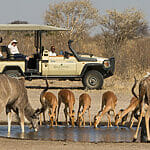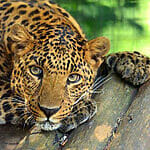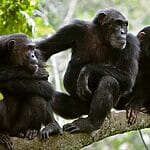Embark on a thrilling journey through the African wilderness and discover the incredible diversity of animals in the safari. From the majestic Big Five to lesser-known but equally fascinating creatures, the African safari offers a once-in-a-lifetime opportunity to witness nature at its finest.
Encounter iconic species such as lions, elephants, and giraffes, and keep an eye out for elusive predators like leopards and cheetahs. Explore the rich ecosystems that support a wide array of animals, from mighty herbivores to agile primates and everything in between.
Quick Answer: Lions, leopards, elephants, rhinos, Cape buffalos, cheetahs, giraffes, zebras, hippos, hyenas, jackals, warthogs, baboons, ostriches, Nile crocodiles, mongooses, hyraxes, porcupines, tree squirrels, and colobus monkeys.
Key Takeaways:
- The Big Five safari animals – African lion, African leopard, African elephant, rhinoceros, and Cape buffalo – are the most sought-after creatures to spot, known for their impressive size, appearance, and crucial roles in the African ecosystem.
- Besides the Big Five, African safaris offer opportunities to see a wide array of other iconic animals, such as cheetahs, giraffes, zebras, hippos, hyenas, jackals, warthogs, baboons, ostriches, and Nile crocodiles.
- Lesser-known but fascinating safari animals, including mongooses, hyraxes, porcupines, tree squirrels, and colobus monkeys, contribute to the rich biodiversity of the African continent and are worth keeping an eye out for during safaris.
The Big Five African Safari Animals
When it comes to African safaris, the term “Big Five” is often mentioned. This refers to the five most sought-after animals that visitors hope to see during their wildlife adventures. The African lion, African leopard, African elephant, rhinoceros, and Cape buffalo make up this iconic group. These magnificent creatures are not only impressive in size and appearance but also play crucial roles in the African ecosystem.
Spotting the Big Five is a thrilling experience for safari-goers, as these animals are not only charismatic but also elusive in their natural habitats. Many safari destinations across Africa, such as Kenya, Tanzania, South Africa, and Botswana, offer excellent opportunities to observe these incredible animals in the wild.
However, it’s important to note that the Big Five are facing various threats, including habitat loss, poaching, and human-wildlife conflicts, making conservation efforts crucial for their survival.
African Lion: The King of the Savanna
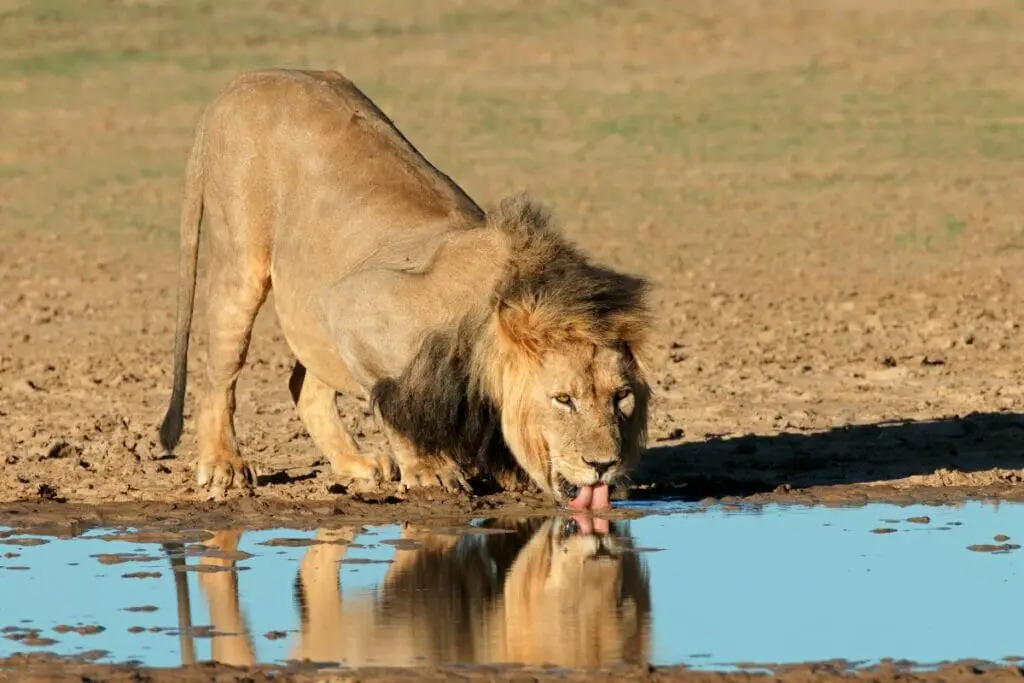
The African lion is the largest of the African big cats and is often referred to as the “king of the jungle.” Male lions are easily recognized by their impressive manes, which can vary in color from light blonde to dark brown. These powerful predators live in social groups called prides, consisting of related females, their cubs, and a few adult males.
Lions are apex predators and play a vital role in maintaining the balance of their ecosystem. They are skilled hunters, with females typically doing most of the hunting for the pride. Their preferred prey includes medium to large mammals such as antelopes, zebras, and wildebeest.
The best places to spot lions in Africa include the Serengeti National Park in Tanzania, the Maasai Mara National Reserve in Kenya, and the Kruger National Park in South Africa. However, like many other wildlife species, lions face threats from habitat loss, human-wildlife conflicts, and illegal hunting. Conservation efforts are ongoing to protect these majestic creatures and ensure their survival for generations to come.
African Leopard: The Elusive Spotted Hunter
The African leopard is known for its stunning spotted coat and incredible agility. These solitary predators are well adapted to various habitats, ranging from dense forests to open savannas. Leopards are excellent climbers and often drag their prey up into trees to keep it safe from other predators.
Unlike lions, leopards are solitary animals and are most active at night, making them challenging to spot on safari. They are stealthy hunters, relying on their exceptional camouflage and stealth to ambush their prey. Leopards are also highly adaptable and can survive in a wide range of environments, from the rainforests of West Africa to the mountainous regions of East Africa.
To increase your chances of seeing a leopard on safari, visit destinations known for their leopard populations, such as Sabi Sands Game Reserve in South Africa, South Luangwa National Park in Zambia, or Moremi Game Reserve in Botswana. Going on night drives and staying alert for signs of leopard activity, such as alarm calls from other animals, can also improve your odds of spotting these elusive cats.
African Elephant: The Gentle Giants of Africa
African elephants are the largest land mammals on Earth, with males weighing up to 6,000 kg (13,200 lbs) and standing up to 3.3 meters (10.8 ft) tall at the shoulder. These gentle giants are known for their intelligence, complex social structures, and their vital role in shaping African ecosystems.
There are two subspecies of African elephants: the savanna elephant and the forest elephant. Savanna elephants are larger and more commonly seen on safaris, while forest elephants are smaller and found in the rainforests of Central and West Africa. Elephants live in close-knit family groups led by a matriarch, usually the oldest and most experienced female.
Elephants face significant threats from poaching for their ivory tusks and habitat loss due to human encroachment. Conservation efforts, such as anti-poaching patrols and community-based conservation projects, are crucial in protecting these magnificent creatures. Some of the best places to observe African elephants include Chobe National Park in Botswana, Amboseli National Park in Kenya, and Hwange National Park in Zimbabwe.
Rhinoceros: The Armored Behemoths
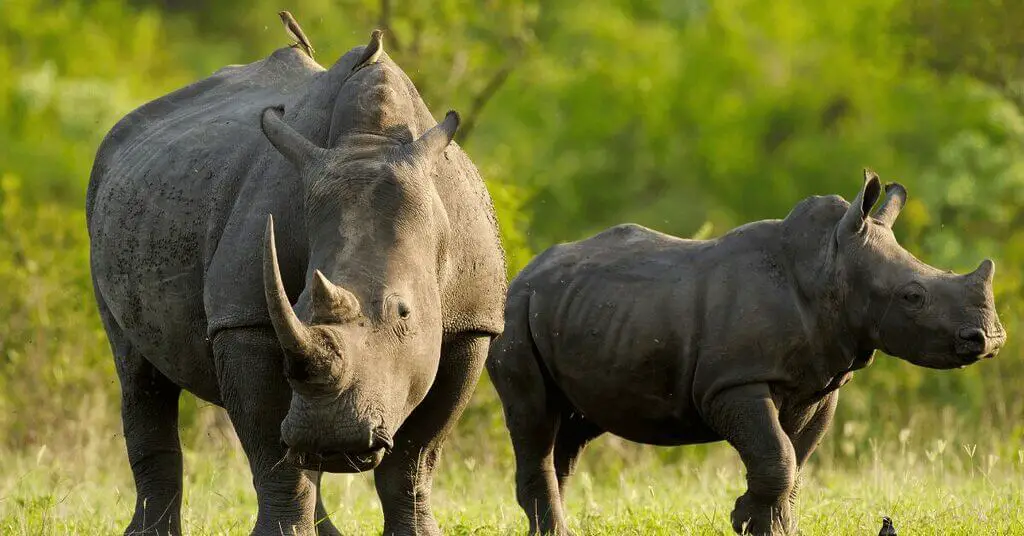
There are two species of rhinoceros found in Africa: the black rhinoceros and the white rhinoceros. Both species are characterized by their large size, thick skin, and distinctive horns. Despite their names, the main difference between black and white rhinos is not their color but rather their lip shape and diet preferences.
Black rhinos are smaller and have a pointed upper lip adapted for browsing on leaves and twigs, while white rhinos are larger and have a square lip suited for grazing on grasses. Sadly, both species have been pushed to the brink of extinction due to poaching for their horns, which are highly valued in traditional Asian medicine.
Conservation efforts have been ramped up to protect rhinos, with many African countries employing armed rangers and strict anti-poaching measures. The best places to see rhinos in the wild include Etosha National Park in Namibia, Hluhluwe-iMfolozi Park in South Africa, and Ol Pejeta Conservancy in Kenya, which is home to the world’s last two northern white rhinos.
Cape Buffalo: The Formidable African Bovine
The Cape buffalo, also known as the African buffalo, is a large bovine species known for its impressive horns and powerful build. These animals live in large herds, which can number in the hundreds, providing protection against predators such as lions and spotted hyenas.
Cape buffalos are often considered one of the most dangerous animals in Africa due to their unpredictable nature and defensive behavior when threatened. They are known to charge at perceived threats, causing serious injury or death to humans and other animals.
These formidable bovines are found in a variety of habitats, from grasslands to forests, across sub-Saharan Africa. Some of the best places to observe Cape buffalo herds include Katavi National Park in Tanzania, Kruger National Park in South Africa, and Chobe National Park in Botswana, where they can often be seen interacting with other wildlife, including their predators.
Other Iconic Animals to Spot on African Safaris
While the Big Five may be the most well-known animals in Africa, African safaris offer an incredible opportunity to witness a wide array of wildlife diversity. From majestic mammals to colorful birds and fascinating reptiles, each species has its own unique characteristics and charm. In this section, we’ll explore some of the other iconic species that you can encounter during your African adventure.
Cheetah: The Fastest Land Mammal
The cheetah is a marvel of nature, renowned for its incredible speed and acceleration. With a sleek build and distinctive spotted coat, cheetahs are built for speed, capable of reaching speeds up to 70 mph (112 km/h) in short bursts. Their unique hunting strategy involves using their explosive speed to chase down prey, typically small to medium-sized antelopes.
Cheetahs are solitary animals, preferring open grasslands where they can use their speed to their advantage. However, they face numerous challenges, including competition with larger predators and habitat loss, making them a vulnerable species. To increase your chances of spotting cheetahs in action, consider visiting:
- Kgalagadi Transfrontier Park, South Africa/Botswana
- Serengeti National Park, Tanzania
- Maasai Mara National Reserve, Kenya
Giraffe: The Tallest Animal on Earth

Standing tall above the African plains, the giraffe is an unmistakable sight with its incredible height, long neck, and distinctive coat patterns. Giraffes have evolved unique adaptations, such as an elongated tongue and a specially adapted cardiovascular system, which allow them to reach leaves high up in the canopy of acacia trees.
Giraffes are social animals, often found in loose herds. There are several subspecies of giraffe, each with slightly different coat patterns and distributions across Africa. Sadly, giraffes face threats from habitat loss and poaching, with some subspecies experiencing a silent extinction. To observe these gentle giants in their natural habitats, visit:
- Etosha National Park, Namibia
- Kruger National Park, South Africa
- Murchison Falls National Park, Uganda
Zebra: The Striped Equine of the Plains
The zebra, with its iconic black and white stripes, is a familiar sight on African savannas. These stripes serve as camouflage against predators, making it difficult for them to single out an individual zebra from the herd. There are three different zebra species: the plains zebra, mountain zebra, and Grevy’s zebra, each with distinct characteristics and habitats.
Zebras are highly social equines, living in harems led by a dominant male or in larger herds. They have a close relationship with wildebeest, often migrating together in search of fresh grazing grounds. As a primary prey species for many predators, zebras play a crucial role in the African ecosystem. To witness zebra herds and their fascinating social dynamics, consider visiting:
- Serengeti National Park, Tanzania (during the Great Migration)
- Chobe National Park, Botswana
- Hwange National Park, Zimbabwe
Hippopotamus: The Semi-Aquatic Heavyweight
The hippopotamus, or “hippo” for short, is a large, barrel-shaped herbivore that spends most of its time in rivers and wetlands. With webbed feet, nostrils, and ears that can close underwater, hippos are well-adapted for a semiaquatic lifestyle. They primarily graze on grass, playing a vital role in maintaining the ecosystem of their aquatic habitats.
Despite their somewhat comical appearance, hippos are known for their aggressive nature and are considered one of the most dangerous animals in Africa. They live in groups called pods, which can consist of up to 30 individuals. To observe hippos in their natural habitat, while keeping a safe distance, consider visiting:
- Zambezi River, Zambia/Zimbabwe
- Ngorongoro Crater, Tanzania
- iSimangaliso Wetland Park, South Africa
Hyena: The Laughing Scavenger
Hyenas are dog-like carnivores known for their powerful jaws, laughing vocalizations, and reputation as skilled hunters and scavengers. There are three hyena species found in Africa, with the spotted hyena being the most well-known and widespread. Spotted hyenas live in matriarchal clans, where females dominate the social hierarchy.
Despite their reputation as scavengers, hyenas are highly adaptable and intelligent predators. They play a crucial role in the ecosystem by cleaning up carcasses and controlling prey populations. To observe hyena behavior and their interactions with other predators, visit:
- Kruger National Park, South Africa
- Maasai Mara National Reserve, Kenya
- Etosha National Park, Namibia
Jackal: The Opportunistic Omnivore
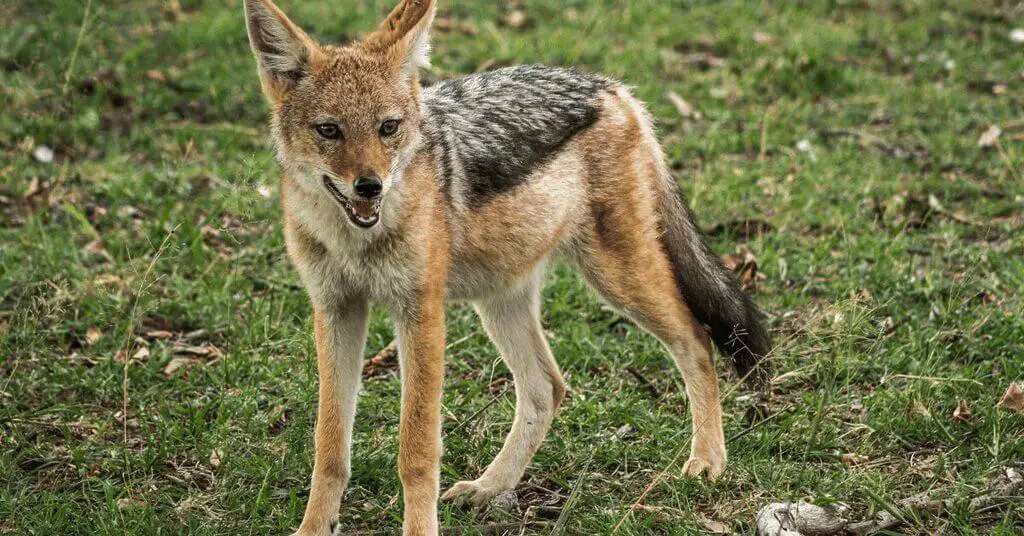
Jackals are small, fox-like canids found in various habitats across Africa. There are three jackal species: the black-backed jackal, side-striped jackal, and golden jackal. These adaptable omnivores are known for their opportunistic nature, scavenging carrion and hunting small prey.
Jackals often form monogamous pairs or small family groups, working together to secure food and defend their territory. As mesopredators, they play a vital role in the ecosystem, controlling rodent and insect populations. To spot jackals and observe their behavior, consider visiting:
- Serengeti National Park, Tanzania
- Kalahari Desert, Botswana
- Pilanesberg National Park, South Africa
Warthog: The Wild Pig with Facial Warts
The warthog is a wild member of the pig family, easily recognized by its large, flat head, prominent facial warts, and upward-curving tusks. These adaptations, along with their muscular snouts and specialized feet, make them excellent diggers in search of roots, tubers, and insects.
Warthogs live in small family groups called sounders and often use abandoned aardvark burrows for shelter. As prey for various large predators, they play a significant role in the ecosystem. Their comical appearance and running gait make them a favorite among safari-goers. To observe warthogs in their natural habitats, visit:
- Addo Elephant National Park, South Africa
- Queen Elizabeth National Park, Uganda
- Tarangire National Park, Tanzania
Baboon: The Intelligent and Social Primate
Baboons are large, terrestrial monkeys found in various habitats across Africa. The most commonly seen species on safaris are the olive baboon and the chacma baboon. These intelligent primates live in large troops with a strict social hierarchy, engaging in complex social behaviors.
As omnivores, baboons have a diverse diet, which includes fruits, insects, and even small mammals. Their adaptability and intelligence have allowed them to thrive in a wide range of environments.
However, they often come into conflict with humans, particularly in areas where their habitats overlap with human settlements. To observe baboon troops and their fascinating social dynamics, consider visiting:
- Lake Nakuru National Park, Kenya
- Mole National Park, Ghana
- Okavango Delta, Botswana
Ostrich: The Largest Flightless Bird
The ostrich is the largest living bird and the fastest-running bird, capable of reaching speeds up to 43 mph (70 km/h). With their long legs, long necks, and small wings unsuitable for flight, ostriches are well-adapted for life on the ground. As omnivores, they feed on a variety of plants, seeds, and insects.
Ostriches have a unique mating system, where males establish territories and mate with multiple females. These birds are well-adapted to life in arid environments, with the ability to go long periods without water. To spot ostriches in open grasslands and savannas, visit:
- Kgalagadi Transfrontier Park, South Africa/Botswana
- Amboseli National Park, Kenya
- Etosha National Park, Namibia
Nile Crocodile: The Apex Aquatic Predator
The Nile crocodile is one of the largest and most feared predators in Africa, inhabiting rivers, lakes, and wetlands. With their scaly armor, powerful jaws, and muscular tails, these apex predators are well-adapted for life in the water. They are known for their ambush hunting techniques, lying in wait at the water’s edge to surprise and drown their prey.
Nile crocodiles play a crucial role in the ecosystem, controlling fish populations and providing food for scavengers. They are also known for their social behavior, often basking in groups to regulate their body temperature. To observe Nile crocodiles in their aquatic habitats, while maintaining a safe distance, consider visiting:
- Chobe River, Botswana
- Murchison Falls National Park, Uganda
- St. Lucia Estuary, South Africa
Remember, while observing these fascinating creatures, it’s essential to respect their territories and follow the guidance of experienced safari guides to ensure both your safety and the well-being of the animals.
Lesser-Known But Fascinating Safari Animals
While the Big Five and other iconic species often steal the spotlight, African safaris offer a chance to discover a wealth of lesser-known but equally captivating animals. From small carnivores to unique primates, and from agile rodents to fascinating reptiles, these often-overlooked creatures contribute to the rich biodiversity of the African continent.
By keeping an eye out for these hidden gems, safari-goers can gain a deeper appreciation for the intricate web of life that exists in the African wilderness.
Mongoose: The Snake-Killing Carnivore

Mongooses are small, agile carnivores renowned for their ability to take on venomous snakes. Two species commonly seen on safaris are the banded mongoose and the dwarf mongoose. These slender-bodied creatures have short legs adapted for quick movements, allowing them to swiftly confront and overcome their serpentine prey.
Mongooses live in family groups called colonies, where they engage in cooperative hunting strategies. Their diet primarily consists of insects, small mammals, and reptiles, including snakes. These fearless predators play a vital role in controlling pest populations and maintaining the balance of their ecosystems. To spot mongooses in action, visit:
- Serengeti National Park, Tanzania
- Chobe National Park, Botswana
- Kruger National Park, South Africa
Hyrax: The Rock-Dwelling Mammal
At first glance, hyraxes might resemble rodents, but these small, furry mammals are actually more closely related to elephants and manatees. Two species to look out for are the rock hyrax and the tree hyrax. Hyraxes have short legs, rounded ears, and a lack of a visible tail, and their specialized feet with rubbery pads provide excellent grip on rocky surfaces.
These social creatures live in colonies dominated by a single male, and their unique vocalizations include whistles, twitters, and shrieks. Hyraxes are prey for various predators, such as eagles and leopards, making them an important part of the food chain. To observe hyraxes sunbathing on rocks or foraging in trees, head to:
- Serengeti National Park, Tanzania
- Table Mountain National Park, South Africa
- Maasai Mara National Reserve, Kenya
Porcupine: The Quill-Covered Rodent
Porcupines are large, nocturnal rodents known for their impressive quills, which serve as a formidable defense mechanism against predators. The crested porcupine and the Cape porcupine are two species found in Africa, both featuring stocky bodies covered in sharp, barbed quills and short, muscular legs.
As nocturnal creatures, porcupines have a keen sense of smell and good night vision, which aid them in finding food such as roots, tubers, bark, and fruits. These solitary animals come together only for mating and play a crucial role in seed dispersal and maintaining the balance of their ecosystems. To increase your chances of spotting these elusive creatures, embark on night drives in:
- Kruger National Park, South Africa
- Etosha National Park, Namibia
- South Luangwa National Park, Zambia
Tree Squirrel: The Acrobatic Forager

Tree squirrels are small, agile rodents perfectly adapted for life in the treetops. With slender bodies, bushy tails, and sharp claws, they effortlessly leap from branch to branch and scurry up and down tree trunks. The red-legged sun squirrel and the striped ground squirrel are two common species encountered on African safaris.
These acrobatic foragers primarily feed on nuts, seeds, fruits, and insects, playing a vital role in seed dispersal. Tree squirrels also serve as prey for various predators, such as birds of prey and small carnivores. To observe their playful antics and foraging behavior, visit:
- Lake Manyara National Park, Tanzania
- Arusha National Park, Tanzania
- Kibale National Park, Uganda
Colobus Monkey: The Black and White Leaf-Eater
Colobus monkeys are striking, leaf-eating primates known for their black and white fur and long, bushy tails. The guereza colobus and the Angola colobus are two species commonly seen on safaris, both featuring a distinctive mantle of long, white hair surrounding their faces and bodies.
These primates have specialized digestive systems that allow them to ferment leaves in their stomach, adapting them to a folivorous diet. Colobus monkeys live in small to medium-sized groups led by a dominant male and play a crucial role in seed dispersal. They are also prey for large predators, such as crowned eagles and chimpanzees. To witness their impressive leaps through the forest canopy, visit:
- Kibale National Park, Uganda
- Nyungwe National Park, Rwanda
- Jozani Chwaka Bay National Park, Zanzibar
Frequently Asked Questions
What is the difference between the African savanna elephant and the African forest elephant?
The African savanna elephant is larger, with a shoulder height of up to 3.3 meters (10.8 ft), while the African forest elephant is smaller, with a shoulder height of about 2.5 meters (8.2 ft). Savanna elephants have more curved tusks and are found in grasslands, while forest elephants have straighter tusks and inhabit dense rainforests.
Are rhinos dangerous to humans?
Rhinos are generally peaceful animals but can become aggressive when they feel threatened. They have poor eyesight and may charge if startled or provoked, making it crucial for humans to keep a safe distance and follow the guidance of experienced safari guides.
What is the purpose of a zebra’s stripes?
A zebra’s stripes serve as camouflage against predators, making it difficult for them to single out an individual zebra from the herd. The stripes may also help regulate body temperature and deter biting flies.
How do hyraxes defend themselves against predators?
Hyraxes have sharp incisors, which they use to bite and defend themselves against smaller predators. They also have a complex system of vocalizations to alert colony members of potential threats, allowing them to quickly retreat to the safety of rocky crevices.
Why are mongooses known for their ability to kill snakes?
Mongooses have quick reflexes, agility, and thick fur, which provide some protection against snake bites. They also have specialized acetylcholine receptors that make them resistant to snake venom, allowing them to tackle venomous snakes with reduced risk.
- Wild Animals in Costa Rica: A Biodiverse Paradise - 2024-05-16
- Animals That Live in the Rainforest: A Diverse Wonder - 2024-05-15
- Animals in the Safari: A Captivating African Adventure - 2024-05-15



